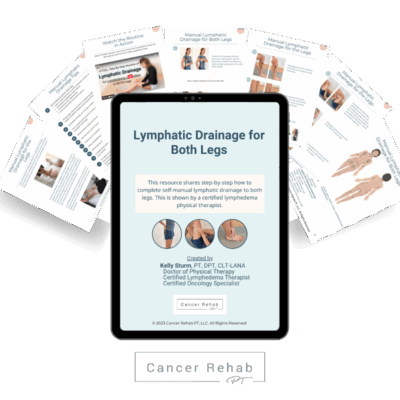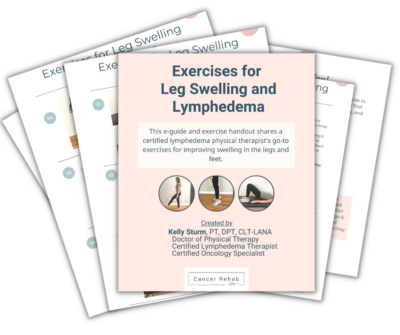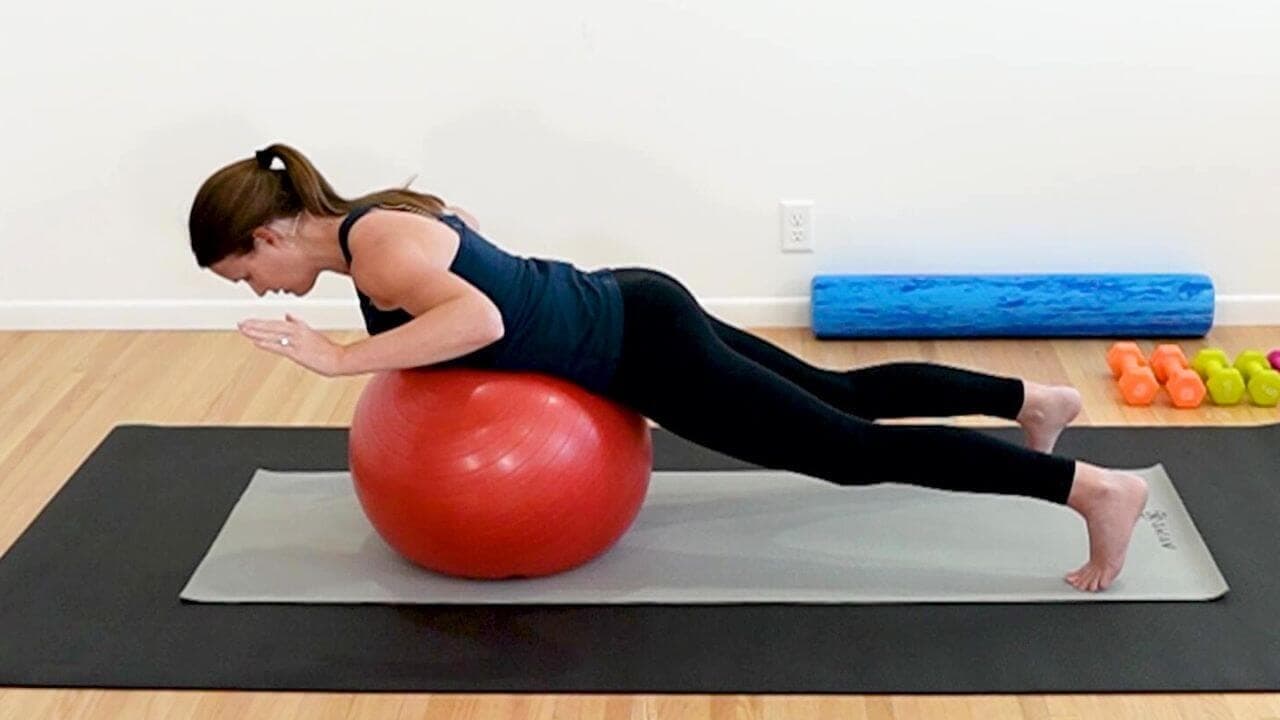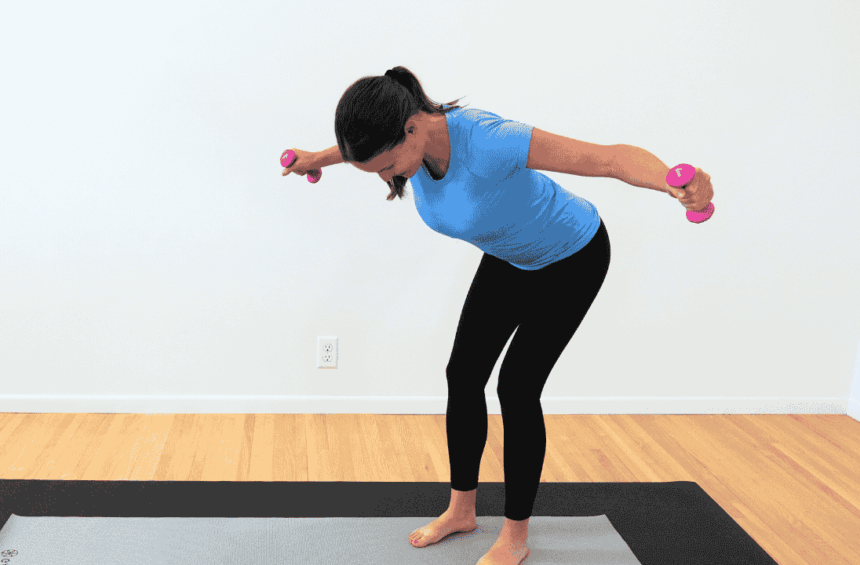Breast cancer recovery rarely happens as quickly as you might hope. It can take months – or even longer – leaving you feeling frustrated and wondering what you can do to help the healing process. I know how discouraging it can be when you’re still dealing with tightness and pain months after surgery.
Breast Cancer Recovery Exercises can help someone regain normal movement and get back to their daily routines.
My name is Kelly, and I am a certified oncology and lymphedema therapist. I specialize in working with patients recovering from breast cancer or those with lymphedema.
In this guide, I am sharing some of my go-to, gentle exercises for 3 months or longer (think the first year or two!) after breast surgery. The stretching and strength exercises focus on helping ease ongoing tightness, stiffness, and pain, and build back strength and mobility.
These exercises are part of my breast cancer recovery series that covers all stages of healing after surgery. Because everyone’s surgery and recovery is different, please make sure you’re cleared by your doctor before trying these.
Looking for earlier stages in recovery? Download my free Breast Recovery Roadmap for all 8 phases.
Why Exercise is Important After Breast Surgery
The American Cancer Society recommends exercise to reduce the side effects of breast cancer surgery- and for a good reason. When you are cleared by your doctor, it is very beneficial to begin an exercise program that focuses on arm and shoulder movement is really beneficial.
Regular exercise after surgery or radiation therapy can also:
- Help lymph fluid flow better through your body
- Help prevent lymphedema (a common side effect of breast cancer treatment)
- Reduce shoulder pain and improve your range of motion.
- Get rid of cording after a mastectomy.
What Are The Most Effective Exercises After Breast Cancer Surgery?
There is no best exercise or one-size-fits-all approach when it comes to starting exercises after breast cancer surgery. However, there are safe and gentle stretching and strength progressions that can help as you continue healing.
A mastectomy is a major surgery, and understanding the recovery process can help you feel more confident about your healing journey. Understanding the best exercises to help you resume daily activities in the healthiest way possible is an important part of the process. Recovery time can range from 3-12 weeks and depends on whether you had breast reconstruction.
If you’re just starting your recovery, I recommend beginning with my early exercises for the first 0-3 weeks to help someone ease into movement and help reduce pain and swelling. If you’re further along, check out my stretching and strength exercises for 9-12 weeks.
Exercises After Breast Cancer Surgery (3+ Months)
We will go through 3 stretching exercises that focus on reducing ongoing tightness and pain, followed by 3 strength exercises to help rebuild muscle strength and alleviate pain to get you back to your daily activities. All exercises should remain mild without significant pain or strain.
As you get further from your surgery, you should start feeling better with less tension. The goal now is to focus on mobility and prevent yourself from getting too tight, especially if you have a desk job or limited movement throughout the day.
These exercises can be done daily, as long as someone is cleared by their doctor or breast care nurse first.
Want to see exactly how to do them? I’ve included a video below where you can follow along with me.
Exercise Details
These stretching and strength exercises are done standing, lying down, and in a kneeling position. These more advanced exercises are for the 3+ months after surgery and focus on arm and shoulder movement.
Equipment Required
- A soft foam roller or towels rolled lengthwise
- A yoga ball or a handful of pillows
- A set of light dumbbells
Stretches
Stretching is a great way to warm up before strength exercises and helps rebuild your arm and shoulder movement. Focus on controlled movements, mild stretches, and deep breathing.
Child’s Pose
This is a stretch many people know, but it’s important to start gently and give yourself control over the movement. There are two ways to do this:

- Option 1: Begin sitting on your knees and slowly start to slide your arms out, with your hands in front of you, palms facing down.
- Option 2: If you prefer, you can start in a kneeled plank position with your hands on the ground underneath your shoulders, and from there, sit back into child’s pose. This offers you more control over how far back you extend and takes pressure off your upper body.
- From your starting position, extend into your child’s pose position until you feel a mild stretch. From there, take a deep breath in. As you exhale, allow yourself to sink further into the stretch.
- Hold for a few seconds, then slowly come back up and rest.
- If you are new to this exercise, I recommend completing shorter holds in the child’s pose position. If you are experienced with this, you can hold for 30 seconds or more.
- Repeat 3-5 times.
Chest Openers on Foam Roller
For this gentle stretch and mobility exercise, you will want a foam roller. I prefer a soft foam roller, as it is more comfortable to lie on. You can also use a rolled towel, as long as it is long enough to extend your body on.
The goal of this exercise is to release any tension we have in the front of the chest.
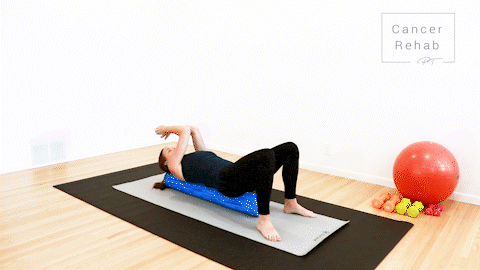
- Begin sitting on the edge of your foam roller or towel, placing your feet a bit wider than hip-width.
- Gently lie back onto the roller and try to support your head on the roller.
- Allow your shoulders to open up and feel a mild stretch.
- From there, bring your palms together in front of your face, so your elbows are bent together around 90 degrees.
- Allow your arms to open up to the sides, feeling the tension and stretch.
- Reach up overhead and then lower your arms back down to your sides before returning together to the starting position.
- Repeat 8 to 10 times.
Sidelying Pec Openers
I recommend doing this stretch on both sides of the body, even if someone has only had breast surgery on one side. It allows you to compare one side to the other, and can help you see progress in your affected side. You will be working on stretching the side that is on top.

- Begin lying on your side with your legs stacked on top of each other and your knees bent. You can use a pillow under your head for support if that is more comfortable. Your bottom arm is resting under your head.
- Reach your top arm out in front of you with your elbow straight.
- Slowly open up your arm towards the wall behind you, with a straight elbow, until you feel a mild stretch across your chest.
- From there, inhale, feeling the tension, before exhaling and sinking further into the stretch.
- Hold for a few seconds before coming back to the starting position.
- Repeat 3 to 5 times.
Strength Exercises
These strength exercises are progressions of exercises done earlier in this series. If someone experiences discomfort or feels pain, they should try a modified version from the 0-3 week guide or exercises for 9-12 weeks.
Ball W’s
For the first strength exercise, you will be using your yoga ball. If you don’t have a ball, you can stack 3 to 4 pillows on top of each other.
After someone has surgery, it is not always ideal to lie on the chest, so I always recommend my patients lie on their abdomen or on their hips.
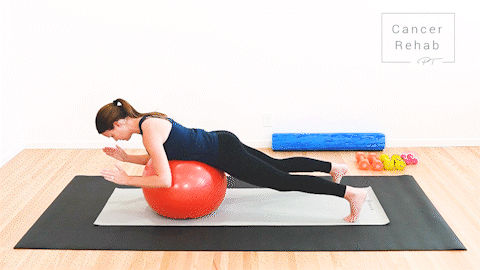
- Start by lying on your abdomen with your knees gently resting on the ground. If it feels more comfortable, you can lift your knees off the ground and stabilize yourself with your toes.
- You want to focus on looking straight up in front of you, rather than craning your neck too far up or tucking your chin all the way down. This helps ensure a neutral spine.
- Bring your arms into a W position. Your elbows will be bent at a 90-degree angle, and your forearms should be straight.
- From there, lift your elbows towards the ceiling and squeeze your shoulder blades at the top.
- Gently come back down and relax.
- Repeat 8-10 times.
Wall Push-Ups with a Plus
This exercise has different variations, depending on someone’s stage in recovery, and helps with postural muscles, shoulder alignment, and shoulder stability.
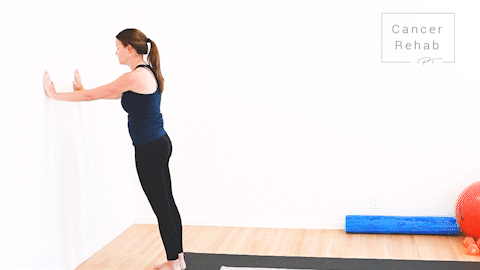
- Stand facing a wall in a neutral position with your hands at shoulder level. Stand far enough away from the wall that you have to reach to touch the wall with your palms, and if you were to release your hands, you would fall forward.
- Fall forward towards the wall into your push-up, then push back up.
- When you get to the top, you are going to do a plus. This is an extra punch with each shoulder moving forward. Your shoulder blades should be rounded and your elbows straight.
Since this guide is designed for recovery 3+ months after surgery, someone may be further along in their journey and ready to progress towards a more challenging version of this strength movement.
- Start in a kneeling plank position with your hands directly underneath your shoulders.
- Keep your elbows close to your sides as you press down into your kneeling push-up.
- Press back up to your starting position.
Over time, you can gradually try to challenge yourself with more repetitions or moving from the wall to your knee push-up and finally to your feet push-up.
Bicep Curl into Shoulder Press
This is an extension of the bicep curl exercise from the 9 to 12 Weeks After Breast Cancer Surgery Guide. Many of our exercises have been done with our arms by our sides. The goal, as someone moves further along in the recovery process, is to regain the range of motion with their arms up overhead.
Regaining a full range of motion is important for feeling confident in many daily life activities, such as reaching high into a cupboard, getting dressed, or bathing. This movement can be done standing, kneeling, or sitting, and as someone becomes more comfortable, they can challenge themselves by increasing weight or repetitions.
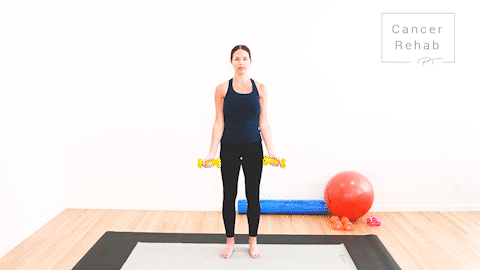
- Begin in a neutral standing position, holding your light weights, with your elbows tucked in slightly in front of your sides and palms facing forward. You may also choose to do hammer curls, where your palms face inward toward your body.
- Bring the weights up towards your shoulders, elbows bent, until you feel a mild squeeze at the top.
- Transition to lifting the weights overhead, feeling a nice, mild stretch as you press up. Focus on keeping your core engaged.
- Slowly bring the weights back down into the starting position.
- Repeat 8 to 10 times.
What to Expect After Breast Cancer Treatment
Breast cancer treatment recovery is emotionally and physically challenging and is unique for everyone. As a Doctor of Physical Therapy and Board Certified Oncology Therapist, I work with patients all across the recovery spectrum- those regaining normal movement and those dealing with breast cancer-related lymphedema.
Beginning breast cancer rehabilitation can help you return to your daily activities and get back to a normal quality of life.
If you are still unsure where to start and are looking for support, you may benefit from Breast Cancer Rehab– it’s a self-paced online program that helps people recovering from breast cancer reduce pain, build strength, and improve their quality of life.
FAQs
What are the exercise recommendations for breast cancer patients?
The general recommendation is to start with gentle movements as soon as your doctor clears you (usually within days of surgery), then gradually progress to more active exercises. Focus on gentle stretches, light strength training, and activities like walking or swimming. The key is consistency and gradual progression – not pushing through pain.
Can you lift weights after breast cancer?
Yes, you can lift weights after breast cancer, but start light and progress gradually. Most people begin with 1-2 pound weights and work up slowly. Always get your doctor’s clearance first, and consider working with a physical therapist who specializes in cancer recovery to ensure you’re doing it safely.
What exercise can I do after a lumpectomy?
After a lumpectomy, you can typically start with gentle arm and shoulder movements within a few days of surgery (once cleared by your doctor). Begin with the exercises in my 0-3 week guide, then progress through the series as you heal. The recovery is usually faster than with a mastectomy, but everyone heals differently.
Final Thoughts
Having a normal quality of life after breast cancer is absolutely possible. I’ve seen thousands of patients get their strength and confidence back. After getting clearance from your doctor, start with gentle activities like these stretches and strength exercises to help regain your normal movement and get back to the things you love.




